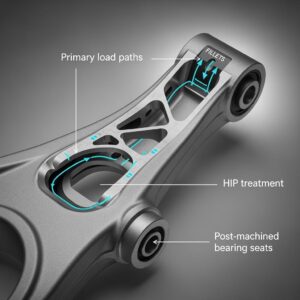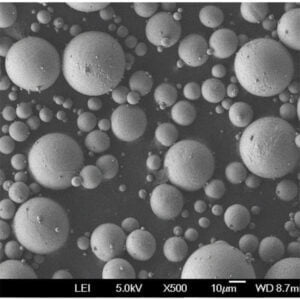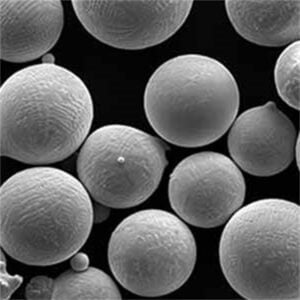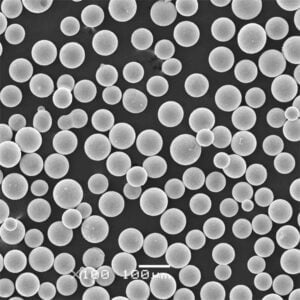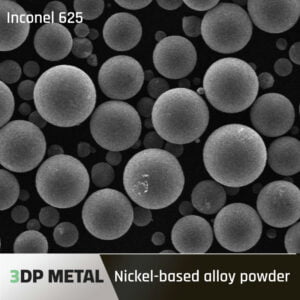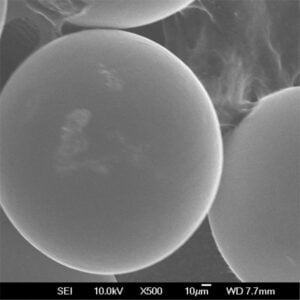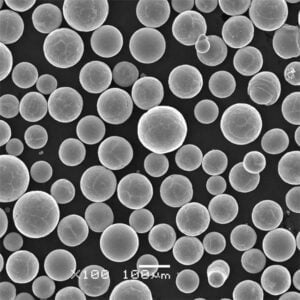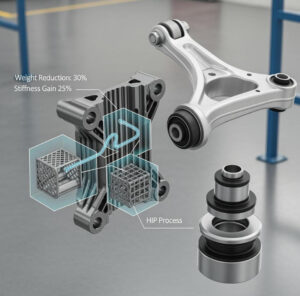니켈 분말: 공급업체, 유형 및 특성
목차
니켈 분말 은 금속 원소인 니켈이 잘게 쪼개진 미립자 형태입니다. 은백색의 이 소재는 뛰어난 특성과 다용도로 인해 다양한 산업 분야에서 주목을 받고 있습니다. 이 글에서는 니켈 분말의 구성, 특성, 용도 및 이 놀라운 소재에 대해 알아야 할 모든 것을 살펴보며 니켈 분말의 세계를 파헤쳐 보겠습니다.
니켈 분말 개요
니켈 분말은 수많은 산업 공정과 제품의 기본 구성 요소입니다. 내식성, 고온 강도, 우수한 전기적 및 자기적 특성으로 잘 알려져 있습니다. 전자 제품부터 화학 공정, 항공 우주, 자동차에 이르기까지 니켈 분말은 다양한 분야에서 중요한 역할을 합니다.
니켈 분말의 구성 및 종류
| 유형 | 구성 | 특성 |
|---|---|---|
| 카보닐 니켈 분말 | 니켈 카보닐 공정을 통해 얻은 순수 니켈 | 고순도, 구형 입자, 우수한 흐름 |
| 전해질 니켈 분말 | 전해 증착으로 생산된 순수 니켈 | 불규칙한 모양의 입자, 높은 표면적 |
| 불활성 가스 분무 니켈 분말 | 불활성 기체에서 원자화된 니켈 합금 | 구형 입자, 제어된 크기 분포 |
| 물 분무 니켈 분말 | 물에 원자화된 니켈 합금 | 소결에 적합한 불규칙한 입자 모양 |
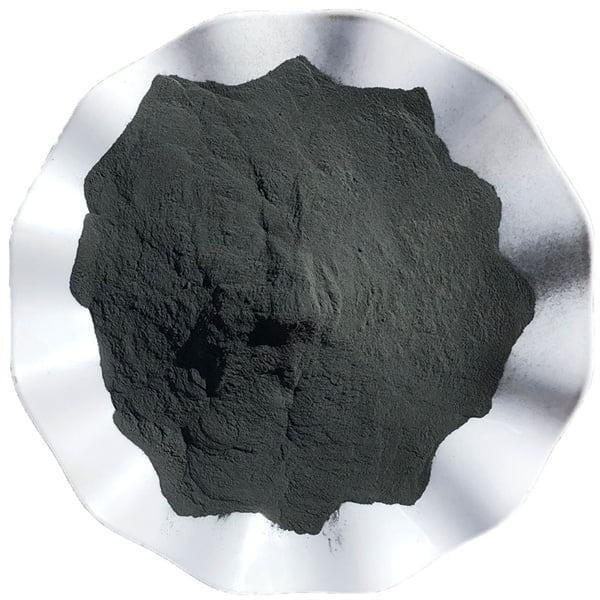
속성 니켈 분말
| 속성 | 특성 |
|---|---|
| 색상 | 은회색 |
| 밀도 | 8.9g/cm³ |
| 융점 | 1455°C(2651°F) |
| 열 전도성 | 90.7W/(m-K) |
| 전기 저항 | 6.99 × 10^-8 Ω-m |
| 자기 속성 | 강자성 |
니켈 분말의 응용 분야
| 애플리케이션 | 설명 |
|---|---|
| 전자 제품 및 배터리 | 니켈-카드뮴 및 니켈-금속 수소 배터리, 전도성 코팅 및 전자 부품에 사용됩니다. |
| 촉매제 | 수소화 및 증기 개질과 같은 다양한 화학 공정에서 촉매로 사용됩니다. |
| 전기 도금 | 니켈 전기 도금은 내식성과 장식적인 마감을 제공합니다. |
| 분말 야금 | 니켈 분말은 고강도, 내마모성 부품 생산에 사용됩니다. |
| 용접 및 브레이징 | 니켈 분말은 용접 및 브레이징 합금의 핵심 성분입니다. |
| 자기 재료 | 영구 자석 및 자기 기록 매체 생산에 활용됩니다. |
사양 및 등급 니켈 분말
| 등급 | 입자 크기 | 순도 | 애플리케이션 |
|---|---|---|---|
| ASTM B438 유형 I | 3-7 μm | 99.8% 분 | 배터리, 촉매, 전자 제품 |
| ASTM B438 유형 II | 3-7 μm | 99.5% 분 | 분말 야금, 코팅 |
| ASTM B438 유형 III | 7-15 μm | 99.5% 분 | 분말 야금, 코팅 |
| ASTM B438 유형 IV | >15μm | 99.5% 분 | 분말 야금, 코팅 |
니켈 분말의 공급업체 및 가격
| 공급업체 | 가격 범위(USD/kg) | 사용 가능한 성적 |
|---|---|---|
| 노릴스크 니켈 | $20 – $30 | 카보닐, 전해질 |
| Vale | $18 – $25 | 카보닐, 불활성 가스 분무 |
| 스미토모 금속 광업 | $22 – $28 | 카보닐, 물 분무 |
| 글렌코어 | $19 – $27 | 카보닐, 전해질 |
| BHP 빌리턴 | $21 – $29 | 카보닐, 불활성 가스 분무 |
니켈 분말의 장단점
| 장점 | 단점 |
|---|---|
| 뛰어난 내식성 | 잠재적인 건강 및 환경 문제 |
| 고온 강도 | 다른 대안에 비해 상대적으로 비싸다 |
| 다양한 애플리케이션 | 특정 화학 환경에 대한 민감성 |
| 자기 속성 | – |
| 전기 전도성 | – |
니켈 분말은 장점보다 단점이 더 많은 경우가 많기 때문에 다양한 산업 분야에서 수요가 높은 소재입니다. 하지만 니켈 분말을 취급하고 폐기할 때는 다음과 같은 주의가 필요합니다. 니켈 분말 책임감 있게 안전 및 환경 규정을 준수합니다.
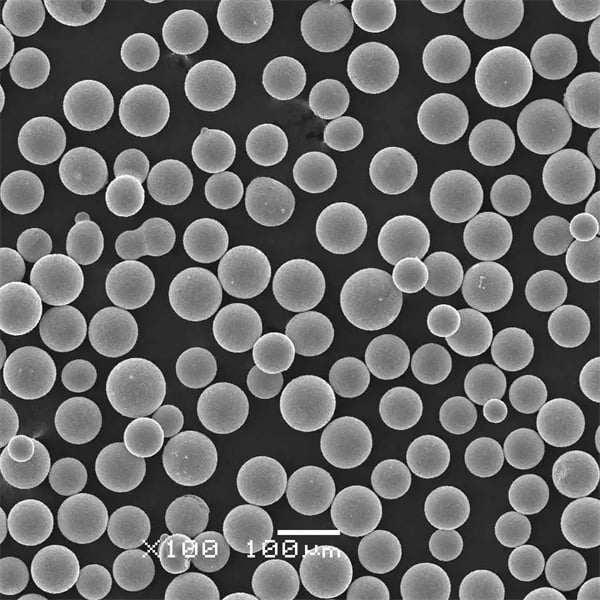
자주 묻는 질문
| 질문 | 답변 |
|---|---|
| 카보닐과 전해 니켈 분말의 차이점은 무엇인가요? | 카보닐 니켈 분말은 화학 공정을 통해 생산되며 입자 모양이 구형인 반면, 전해 니켈 분말은 전해 증착을 통해 얻어지며 입자 모양이 불규칙합니다. 일반적으로 카보닐 분말은 순도가 높고 흐름 특성이 더 우수합니다. |
| 니켈 분말은 배터리에 어떻게 사용되나요? | 니켈 분말은 니켈-카드뮴(Ni-Cd) 및 니켈-금속수소(Ni-MH) 충전식 배터리의 핵심 구성 요소로 양극 재료로 사용됩니다. |
| 분말 야금에서 니켈 분말을 사용하면 어떤 이점이 있나요? | 니켈 분말은 소결된 부품에 우수한 기계적 특성, 내식성 및 내마모성을 제공합니다. 고성능 부품을 생산하기 위해 다른 금속 분말과 함께 사용되는 경우가 많습니다. |
| 니켈 파우더와 관련된 건강상의 문제는 없나요? | 예, 니켈 화합물은 일부 사람들에게 피부 자극과 호흡기 문제를 일으킬 수 있습니다. 니켈 파우더로 작업할 때는 적절한 취급 및 안전 조치를 취해야 합니다. |
| 니켈 분말의 입자 크기는 용도에 어떤 영향을 미치나요? | 입자 크기가 작을수록 일반적으로 표면적과 반응성이 높아지므로 촉매 및 전기 화학 공정과 같은 응용 분야에 적합합니다. 분말 야금 및 코팅에는 입자 크기가 큰 것이 선호됩니다. |
결론적으로 니켈 분말은 다양한 산업 분야에서 활용되는 놀라운 소재입니다. 전자제품과 배터리부터 촉매와 분말 야금에 이르기까지 이 다재다능한 소재는 우리 주변의 세상을 계속 변화시키고 있습니다. 기술이 발전함에 따라 니켈 분말에 대한 수요는 증가할 것이며, 니켈 분말의 잠재력에 대한 혁신과 탐구가 더욱 가속화될 것입니다.
Frequently Asked Questions (Advanced)
1) What impurity and morphology specs matter most when selecting Nickel Powder for batteries vs. powder metallurgy?
- Batteries: prioritize carbonyl nickel powder with high purity (≥99.8%), low S (≤10–50 ppm), low Fe/Co/Cu impurities, and D50 ~3–7 µm for high surface area. Powder metallurgy: inert gas atomized powders with controlled PSD (typically 10–45 µm or 20–63 µm), spherical shape for flow, and oxygen <0.15 wt% to limit oxide inclusions.
2) How does particle size distribution (PSD) influence sintered density and conductivity in Ni-based parts?
- Narrow PSD with sufficient fines improves packing and green density, enabling higher sintered density and conductivity. Excess fines increase oxide and reduce flow; too coarse reduces green strength. Target Hausner ratio ≤1.25 and Hall flow <40 s/50 g where applicable.
3) Is Nickel Powder suitable for additive manufacturing (AM)?
- Yes. Gas-atomized Nickel Powder and Ni alloys (e.g., Inconel, NiCr) are used in LPBF/DED. Key specs: spherical morphology, PSD aligned to process (15–45 µm for LPBF; 45–106 µm for DED), oxygen typically <0.08–0.12 wt% for consistent melt behavior.
4) What are best practices for safe handling and exposure control?
- Follow NFPA 484 for combustible metals; use grounded equipment, local exhaust ventilation (LEV), and HEPA filtration. For health, follow OSHA/ACGIH limits (e.g., ACGIH TLV-Ni metal inhalable 1 mg/m³; lower for soluble compounds). Implement Dust Hazard Analysis (DHA), anti-static PPE, and segregated storage.
5) How do carbonyl vs. electrolytic Nickel Powder compare for catalytic applications?
- Carbonyl nickel often exhibits higher purity, controlled surface chemistry, and uniform small particle size, yielding higher catalytic activity and reproducibility. Electrolytic nickel’s higher surface area can be beneficial but requires tighter impurity control and pre-treatment to remove surface oxides.
2025 Industry Trends
- Battery and hydrogen economy pull: Rising demand from Ni-based battery chemistries (NiMH, alkaline) and hydrogenation catalysts; increased scrutiny on impurity profiles and ESG reporting.
- Supply diversification: More atomization capacity outside traditional regions to reduce geopolitical risk; recycled Ni streams integrated with certified traceability.
- AM-ready nickel: Growth in gas-atomized Ni alloy powders for LPBF/DED with tighter oxygen specs and digital powder passports per ISO/ASTM 52907.
- EHS tightening: Stricter workplace exposure monitoring for nickel compounds; broader adoption of DHA, LEV performance testing, and medical surveillance.
- Price stabilization strategies: Producers deploy hedging and long-term offtake with automotive and energy sectors to mitigate volatility.
2025 Snapshot: Nickel Powder Market and Quality Metrics
| 메트릭 | 2023 Baseline | 2025 Estimate | Notes/Source |
|---|---|---|---|
| Carbonyl Ni typical purity (%) | 99.5–99.8 | 99.7–99.9 | Tighter impurity control in carbonyl process |
| Oxygen content, gas-atomized Ni alloys (wt%) | 0.10–0.18 | 0.07–0.12 | Improved atomization + handling |
| Share of AM-grade Ni powders with digital passports | 15–25% | 40–60% | Adoption in aerospace/energy |
| Spot price volatility (std. dev. YoY, %) | 높음 | 보통 | Hedging, long-term contracts |
| Recycled content in Ni powder supply (%) | 15-30 | 25–45 | ESG targets, certified streams |
Selected references:
- ISO/ASTM 52907 (metal powder quality for AM); ASTM B438 (nickel powder for PM) — https://www.iso.org | https://www.astm.org
- NFPA 484: Combustible Metals — https://www.nfpa.org
- ACGIH TLVs/OSHA guidance on nickel exposure — https://www.osha.gov
Latest Research Cases
Case Study 1: Carbonyl Nickel Powder Optimization for High-Loading Catalysts (2025)
- Background: A chemicals producer sought higher hydrogenation throughput without increasing reactor size.
- Solution: Specified carbonyl Nickel Powder with D50 4–6 µm, sulfur <20 ppm, and controlled passivation; implemented in-line particle classification and inert packaging.
- Results: Catalyst activity +12–15% vs. prior lot; deactivation rate reduced 10%; batch-to-batch variability halved (RSD of activity from 6.2% to 3.1%).
Case Study 2: AM-Grade Gas-Atomized Nickel Alloy Powder for LPBF Turbomachinery Seals (2024)
- Background: An energy OEM needed consistent build quality on thin-wall Ni-alloy seals.
- Solution: Switched to inert gas-atomized NiCr-based powder with O = 0.08–0.10 wt%, PSD 15–45 µm, digital powder passport; tuned scan strategies and contour remelts.
- Results: Relative density 99.92% average; CT-detected defect rate −35%; fatigue life at 10^7 cycles +22% after shot peening; scrap rate −18%.
전문가 의견
- Prof. Randall M. German, Powder Metallurgy Expert
- Viewpoint: “Gas-to-metal ratio and PSD control are decisive for nickel powder consistency—flow and packing dictate sintered performance more than many realize.”
- Dr. Christina Noguez, Senior Scientist, Fraunhofer IFAM
- Viewpoint: “For AM, oxygen management from atomization through handling is the gating factor; trace O swings can double lack-of-fusion defects in nickel alloys.”
- James Sears, VP Technology, Carpenter Additive
- Viewpoint: “Digital material passports linking powder genealogy to in-process data are quickly becoming standard for nickel powders in regulated industries.”
Practical Tools/Resources
- Standards and QA
- ASTM B438 (nickel powders for PM), ISO/ASTM 52907 (AM powder quality), ASTM E2491 (laser diffraction PSD) — https://www.astm.org | https://www.iso.org
- Safety and compliance
- NFPA 484 for combustible metals; OSHA/ACGIH exposure limits and controls — https://www.nfpa.org | https://www.osha.gov
- Data and handbooks
- ASM Handbook Vol. 7 (Powder Metallurgy), Vol. 24 (Additive Manufacturing) — https://www.asminternational.org
- Testing and characterization
- Hall/Carney flow (ASTM B213/B821), apparent/tap density (ASTM B212/B527), oxygen/nitrogen by inert gas fusion
- AM ecosystem
- NIST AM Bench datasets; OEM LPBF parameter guides for Ni alloys — https://www.nist.gov
Last updated: 2025-10-17
Changelog: Added advanced FAQ tailored to batteries, PM, and AM; 2025 trend snapshot with market/quality KPIs; two recent case studies (catalyst optimization; AM turbomachinery seals); expert viewpoints; and curated standards/safety/resources links
Next review date & triggers: 2026-04-30 or earlier if ISO/ASTM standards for nickel powders are revised, workplace exposure limits change, or AM datasets show ≥25% defect reduction via new oxygen control methods
공유
중국 칭다오에 본사를 둔 선도적인 적층 제조 솔루션 제공업체인 MET3DP Technology Co. 당사는 산업용 3D 프린팅 장비와 고성능 금속 분말을 전문으로 합니다.
관련 기사
